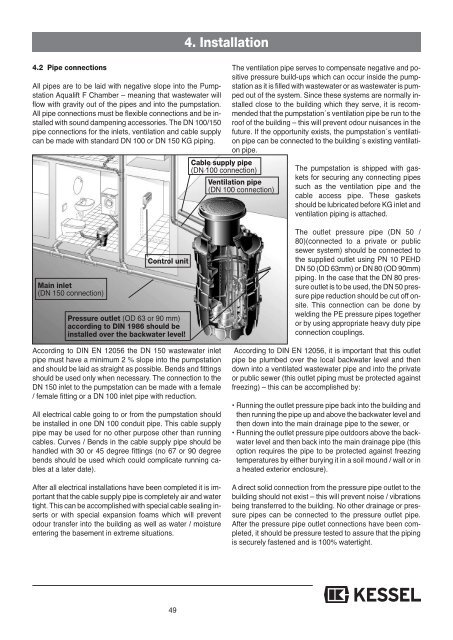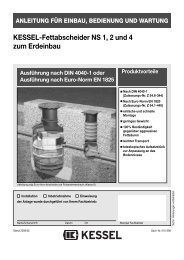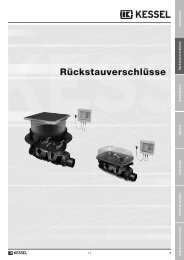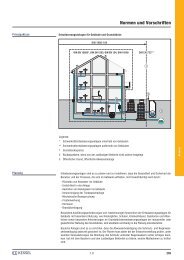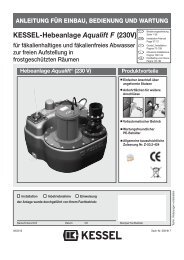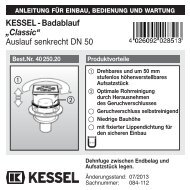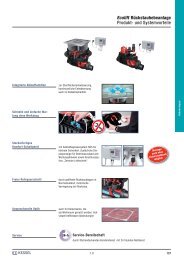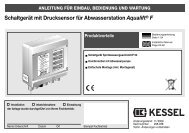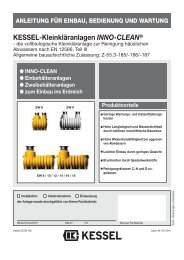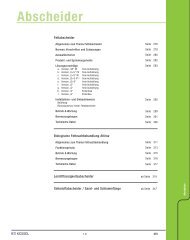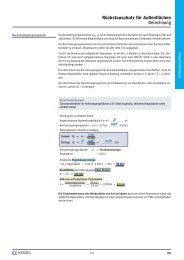Create successful ePaper yourself
Turn your PDF publications into a flip-book with our unique Google optimized e-Paper software.
4. Installation<br />
4.2 Pipe connections<br />
All pipes are to be laid with negative slope into the Pumpstation<br />
Aqualift F Chamber – meaning that wastewater will<br />
flow with gravity out of the pipes and into the pumpstation.<br />
All pipe connections must be flexible connections and be installed<br />
with sound dampening accessories. The DN 100/150<br />
pipe connections for the inlets, ventilation and cable supply<br />
can be made with standard DN 100 or DN 150 KG piping.<br />
The ventilation pipe serves to compensate negative and positive<br />
pressure build-ups which can occur inside the pumpstation<br />
as it is filled with wastewater or as wastewater is pumped<br />
out of the system. Since these systems are normally installed<br />
close to the building which they serve, it is recommended<br />
that the pumpstation´s ventilation pipe be run to the<br />
roof of the building – this will prevent odour nuisances in the<br />
future. If the opportunity exists, the pumpstation´s ventilation<br />
pipe can be connected to the building´s existing ventilation<br />
pipe.<br />
Cable supply pipe<br />
(DN 100 connection)<br />
Ventilation pipe<br />
(DN 100 connection)<br />
The pumpstation is shipped with gaskets<br />
for securing any connecting pipes<br />
such as the ventilation pipe and the<br />
cable access pipe. These gaskets<br />
should be lubricated before KG inlet and<br />
ventilation piping is attached.<br />
Main inlet<br />
(DN 150 connection)<br />
Control unit<br />
Pressure outlet (OD 63 or 90 mm)<br />
according to DIN 1986 should be<br />
installed over the backwater level!<br />
According to DIN EN 12056 the DN 150 wastewater inlet<br />
pipe must have a minimum 2 % slope into the pumpstation<br />
and should be laid as straight as possible. Bends and fittings<br />
should be used only when necessary. The connection to the<br />
DN 150 inlet to the pumpstation can be made with a female<br />
/ female fitting or a DN 100 inlet pipe with reduction.<br />
All electrical cable going to or from the pumpstation should<br />
be installed in one DN 100 conduit pipe. This cable supply<br />
pipe may be used for no other purpose other than running<br />
cables. Curves / Bends in the cable supply pipe should be<br />
handled with 30 or 45 degree fittings (no 67 or 90 degree<br />
bends should be used which could complicate running cables<br />
at a later date).<br />
After all electrical installations have been completed it is important<br />
that the cable supply pipe is completely air and water<br />
tight. This can be accomplished with special cable sealing inserts<br />
or with special expansion foams which will prevent<br />
odour transfer into the building as well as water / moisture<br />
entering the basement in extreme situations.<br />
The outlet pressure pipe (DN 50 /<br />
80)(connected to a private or public<br />
sewer system) should be connected to<br />
the supplied outlet using PN 10 PEHD<br />
DN 50 (OD 63mm) or DN 80 (OD 90mm)<br />
piping. In the case that the DN 80 pressure<br />
outlet is to be used, the DN 50 pressure<br />
pipe reduction should be cut off onsite.<br />
This connection can be done by<br />
welding the PE pressure pipes together<br />
or by using appropriate heavy duty pipe<br />
connection couplings.<br />
According to DIN EN 12056, it is important that this outlet<br />
pipe be plumbed over the local backwater level and then<br />
down into a ventilated wastewater pipe and into the private<br />
or public sewer (this outlet piping must be protected against<br />
freezing) – this can be accomplished by:<br />
• Running the outlet pressure pipe back into the building and<br />
then running the pipe up and above the backwater level and<br />
then down into the main drainage pipe to the sewer, or<br />
• Running the outlet pressure pipe outdoors above the backwater<br />
level and then back into the main drainage pipe (this<br />
option requires the pipe to be protected against freezing<br />
temperatures by either burying it in a soil mound / wall or in<br />
a heated exterior enclosure).<br />
A direct solid connection from the pressure pipe outlet to the<br />
building should not exist – this will prevent noise / vibrations<br />
being transferred to the building. No other drainage or pressure<br />
pipes can be connected to the pressure outlet pipe.<br />
After the pressure pipe outlet connections have been completed,<br />
it should be pressure tested to assure that the piping<br />
is securely fastened and is 100% watertight.<br />
49


